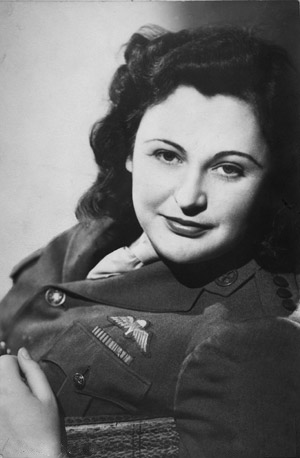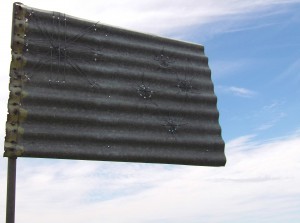 Chances are you’ve heard the words ‘crazy’ and ‘Kiwi’ in the same sentence. This is because New Zealanders are insane. No concern for personal safety, they throw themselves headlong into their obsessions, combining inherent ingenuity with mad optimism. Kiwis can conquer the world with a piece of number 8 wire, or so they enjoy telling themselves.
Chances are you’ve heard the words ‘crazy’ and ‘Kiwi’ in the same sentence. This is because New Zealanders are insane. No concern for personal safety, they throw themselves headlong into their obsessions, combining inherent ingenuity with mad optimism. Kiwis can conquer the world with a piece of number 8 wire, or so they enjoy telling themselves.
Reading this list of crazy kiwis, however, you might well believe it. The following 10 New Zealanders all displayed varying degrees of insanity – the brilliant kind of insanity – and have consequently left their mark upon on history:
1) Charles Upham
The life of Captain Charles Upham reads like an episode of Michael Palin’s Ripping Yarns. Born in Christchurch in 1908, Upham received not one, but two Victoria Crosses for his actions during World War II – the only person on the planet to achieve this. Before the war, he worked as a sheep farmer, (because what else is a New Zealander supposed to do?) During the war, he was a badass who single-handedly destroyed tanks and kept on fighting despite broken limbs, dysentery and being riddled with bullets. Eventually, he was taken as a prisoner of war, but the badassery didn’t stop there.
You see, Upham had what the Germans considered a nasty habit of trying to escape. Once, when he was with a group of POWs being transported by truck, he made a daring leap for freedom. He broke his ankle upon landing, but still made it 400 yards before he was caught.  Another time, he was being transported by train. To prevent another daring leap for freedom, he was only allowed to go to the toilet when the train was moving at high speed. This, however, didn’t stop him. Unfortunately, being knocked unconscious on the tracks did.
Another time, he was being transported by train. To prevent another daring leap for freedom, he was only allowed to go to the toilet when the train was moving at high speed. This, however, didn’t stop him. Unfortunately, being knocked unconscious on the tracks did.
Yet another time, he tried to climb a camp fence – in broad daylight. As you might imagine, this didn’t go so well and he got himself all caught up in barbed wire. But as he waited for the guards to arrive and shoot him, he did his most badass thing yet: lying there, casual as you please, he lit a cigarette. This amused the guards so much that they didn’t kill him. Instead, they took a photograph and let him back inside.
All these escape attempts – and several others besides – landed Upham in Colditz. He was there when Colditz was liberated by the Americans. As you’d expect, most of the POWs were now very eager to get home, but not Upham. He immediately armed himself and, presumably, roared, “Let me at ’em!”
2) Edmund Hillary
Of course this list was going to include Sir Edmund Hillary. Though he wasn’t quite the tank-killing badass Upham was, he shared Upham’s mad disregard for personal safety. Good thing too, or he’d have never conquered Everest. His attitude was ‘get to the top, or die doing it’. There he and Sherpa Tenzing were – sleep-deprived, affected by the altitude, scarily low on oxygen supplies – facing weather conditions that would have made any sane person turn back, and they carried on. And what did Hillary say when they’d returned victorious?
“We knocked the bastard off.”
3) A. J. Hackett
Any person who thinks it’s a good idea to tie a bungy cord round their ankles and leap from a great height must be at least a little insane. New Zealand’s Alan John Hackett turned it into an industry.
Born in Pukekohe, but raised on the North Shore, Hackett’s first bungy jump was off Auckland’s Upper Harbour Bridge. (He tested the cord with a bag of rocks first, which shows more foresight than most Kiwis.) The fact that he didn’t die encouraged him to jump off more and more bridges around New Zealand, but he wanted to get the attention of the world. What better way to do that than sneak up the Eifel Tower one evening, spend the night up there, and jump off it the next morning? That’s exactly what he did on June 26th, 1987.
He was arrested immediately afterwards, but – hey – totally worth it. The rest, as they say, is history.
4) Bill Hamilton
 In 1974, South Islander Charles William Feilden Hamilton was knighted for his services to manufacturing. These included inventing a method of propelling oneself very quickly up very shallow rivers: the jet boat. I’ve been jet boating several times, and it really is insane – insanely fun, that is. I remember thinking, ‘The bloke who invented this must have been a right nutter.’ No, he was just a Kiwi.
In 1974, South Islander Charles William Feilden Hamilton was knighted for his services to manufacturing. These included inventing a method of propelling oneself very quickly up very shallow rivers: the jet boat. I’ve been jet boating several times, and it really is insane – insanely fun, that is. I remember thinking, ‘The bloke who invented this must have been a right nutter.’ No, he was just a Kiwi.
From typical Kiwi bloke tinkering away in a shed to triumphant silencer of critics, Hamilton became an inspiration to mad inventors everywhere. His invention was the first boat ever to travel up and down the Grand Canyon. Like A. J. Hackett, Hamilton’s daring spawned an industry. Chances are you’ll find yourself riding a jet boat when you come to New Zealand!
5) Burt Munro
Who’s seen The World’s Fastest Indian? Well that was about this guy. (Not an Indian, a Kiwi.) Born in Invercargill – the city Mick Jagger described as ‘the arsehole of the world’ – Burt Munro had a need for speed. Growing up on a farm – New Zealand, remember – he dreamed of escaping Invercargill, because who doesn’t?
In 1920, Munro got himself an Indian ‘Scout’ motorcycle and started modifying it to go faster. Poor as he was, he’d make his own parts out of old tins, often working all through the night, as he had a full-time job. After his wife divorced him – God knows why – he gave up his job and lived in a garage with his tools.
After about 40 years of modifying and re-modifying the Indian, Munro took it all the way to Utah to test its speed on the Bonneville Salt Flats. As a man in his sixties, he set three world records, one of which stands to this day.
6) Nancy Wake
 Nancy Grace Augusta Wake was one of the most decorated servicewomen of World War II. As badass in her way as Charles Upham, Wake was an important guerrilla fighter in the French Resistence and the Gestapo’s most wanted. She killed a member of the SS with her bare hands for goodness’ sake!
Nancy Grace Augusta Wake was one of the most decorated servicewomen of World War II. As badass in her way as Charles Upham, Wake was an important guerrilla fighter in the French Resistence and the Gestapo’s most wanted. She killed a member of the SS with her bare hands for goodness’ sake!
Wake was born in Wellington in 1912. (We’ll ignore the fact that her family moved to Australia in 1914.) At the age of 16, she ran away from home. By the 1930s, she was a journalist in Europe and, as such, witness to the rise of the Nazis. In 1939, she married a Frenchman, and was living in Marseille when Germany invaded. She joined the Resistance as a courier.
With the looks of a femme fetale, Wake had a particular talent for charming her way past guards and eluding capture. The Gestapo called her the White Mouse, which sounds pretty cool. She was forced to flee Marseille in 1943, but her husband was captured, tortured and executed. She’d soon be back with a vengeance. In 1944, working for the British Special Operations Executive, she parachuted into Auvergne to make contact with the Resistance. The local leader found her tangled up in a tree and said, “I hope that all the trees in France bear such beautiful fruit this year.” She said, in her badass way, “Don’t give me that French shit.”
Wake had no compunction about shooting people in cold blood, nor killing Nazis with her bare hands, and claimed to have never been afraid in her life. Upon being offered honours by the Australian government, she told them “they could stick their medals where the monkey stuck his nuts.” Awesome.
7) Peter Jackson
Now Sir Peter Jackson is completely insane. His obsession with making The Lord of the Rings and The Hobbit films as accurate possible extended to having the sets, costumes and props rendered in such minute detail that you’d never see it all on screen. Take the Hobbiton set, for example. It was built as an actual, proper village that could be lived in by Council standards. Most of it didn’t even make it into the films, or only made it in for second. There were trees in the village that were different to the particular trees that Tolkien mentioned in his books, so what did Jackson do? He had each individual leaf and fruit removed and replaced with thousands of individual fake leaves and fruits of the right sort. Mad!
Jackson’s earlier works include the gory Bad Taste and the even gorier Braindead. If the films themselves don’t disturb you, trying thinking about the mind they sprung from! When he was a little kid, he tried to remake King Kong with his own stop motion effects. He also dug up his parents’ lawn in an effort to recreate the Somme. Jackson is a self-taught filmmaker, showing as much of the backyard inventive genius as Burt Munro or Bill Hamilton. He’s done so much for New Zealand and I can’t wait to see what he does next.
8) Jean Batten
 Jean Gardner Batten was one ballsy lady. Born in Rotorua, she became, in 1936, the first person ever to fly solo from England to New Zealand. Before that, she’d well and truly beaten Amy Johnson’s England-to-Australia solo flight, and afterwards she continued to break records. She was world-famous and always made sure she emerged from the cockpit perfectly made-up. She was sexy and she knew it. (She wasn’t above batting her eyelashes at men to fund her flights.)
Jean Gardner Batten was one ballsy lady. Born in Rotorua, she became, in 1936, the first person ever to fly solo from England to New Zealand. Before that, she’d well and truly beaten Amy Johnson’s England-to-Australia solo flight, and afterwards she continued to break records. She was world-famous and always made sure she emerged from the cockpit perfectly made-up. She was sexy and she knew it. (She wasn’t above batting her eyelashes at men to fund her flights.)
She was ambitious and eccentric, yet despite apparently relishing attention, Batten became increasingly reclusive. She died in obscurity – no one even knew about it until five years afterwards – from a dog bite that she refused to get treatment for. Ah well. Anyone who’s ever entered Auckland Airport knows how much New Zealand loves her.
9) Richard Pearse
Richard Pearse, the South Island farmer who may well have achieved mechanical flight nine months before the Wright Brothers, was actually nicknamed ‘Mad Pearse’. People laughed at his inventions and they laughed when he crashed into hedges, but on (possibly) 31st March, 1903, he flew his monoplane (possibly) 140 metres. Before injuring his collarbone crashing into a hedge.
It’s frustrating that his flight attempts weren’t properly recorded. He consequently died in obscurity. Even if Pearse did beat the Wright Brothers into the air, however, his flight was not controlled as theirs was. His achievement, though, was possibly more remarkable, as he had no money and no mechanical training. He was just a Kiwi in a shed working with scrap, like Burt Munro and many, many others.
10) Glenn Martin
 Glenn Martin certainly fits the now-familiar crazy-Kiwi-inventing-things-by-night-in-a-garage type. You may not have heard of him, but you’re about to. The thrill-seeker from Dunedin has spent the last 30 years inventing a proper, commercially-viable jetpack.
Glenn Martin certainly fits the now-familiar crazy-Kiwi-inventing-things-by-night-in-a-garage type. You may not have heard of him, but you’re about to. The thrill-seeker from Dunedin has spent the last 30 years inventing a proper, commercially-viable jetpack.
Yes, that’s right. A jetpack.
Apparently, one night in the early ’80s, Martin was sitting around with his uni mates. They were talking about how disappointed they were that jetpacks hadn’t been invented yet and, well, Martin decided to take matters into his own hands. He’d always liked building things – a trait that had made him somewhat of a fire hazard as a kid – and by the time he left university, he’d already designed a ducted fan flying machine.
Soon to go on sale, (for $150,000,) the Martin Jetpack is capable flying for a full thirty minutes, reaching speeds of 74km an hour and heights of over 800 feet. Just goes to show that Kiwis can invent anything.
Article by Abigail Simpson, author of POMS AWAY! A British Immigrant’s View of New Zealand